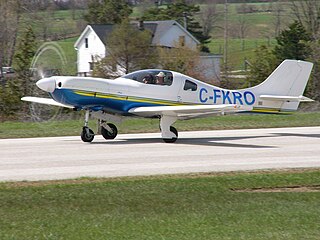
The CAP Aviation CAP-23x family is a family of aircraft designed for competition aerobatics. The CAP 230 airframe was a direct development of the CAP 21 competition single seater strengthened to cope with a 300 hp (220 kW) 6-cylinder Lycoming AEIO-540 engine instead of the 200 hp (150 kW) original 4-cylinder Lycoming AEIO-360.

PZL M26 Iskierka or M26 Airwolf is a Polish trainer and aerobatic aircraft, designed at WSK PZL-Mielec.

The Auster J/1U Workmaster is a late 1950s British single-engined single-seat high-wing agricultural monoplane built by Auster Aircraft Limited at Rearsby, Leicestershire. Of traditional high-wing layout, it carries 90 gallons of spray fluid in a tank beside the pilot, an extra seat being provided for a passenger. The Lycoming 0-360-A engine of 180 h.p. driving a McCauley v.p. propeller giving it ample power; and slotted ailerons and balanced tail controls providing good handling. Oversize tyres were fitted. Take-off run at 2,550 lb gross weight and cruising speed at 65 per cent power are respectively 180 yd and 88 miles per hour (142 km/h). Britten-Norman spray gear was provided by Crop Culture, and this company ordered nine Workmasters.

The Partenavia P.64B/P.66B Oscar is an Italian two/four-seat, single-engined, high-wing monoplane built by Partenavia.

The PZL-105 Flaming (flamingo) is a Polish short-takeoff-and-landing (STOL) utility aircraft designed by PZL "Warszawa-Okęcie". It remained a prototype.

The Call-Air Model A is an American two- to three-seat utility aircraft designed by the Call brothers and built by the Call Aircraft Company, later developed into a successful line of agricultural aircraft.

The Zlin Z-526 Akrobat is a Czech sports plane used in aerobatics.

The AS/SA 202 Bravo is a two to three-seat civil light aircraft jointly designed and manufactured by the Swiss company Flug- und Fahrzeugwerke Altenrhein (FFA) and the Italian company Savoia-Marchetti. The aircraft was designated the AS 202 in Switzerland, and the SA 202 in Italy.

The Lancair 320 is a two-seat single-engined light aircraft marketed in kit form by the U.S. general aviation manufacturer Lancair. It is based on the Lancair 235, but with a larger fuselage and more powerful engine, and like the 235, it is a low-winged monoplane of composite construction with a retractable tricycle undercarriage, with side-by-side seating in an enclosed cockpit. The Lancair 360 is similar, but with a more powerful engine.

The Malmö MFI-10 Vipan was a four-seat light utility monoplane designed and built in Sweden by Malmö Flygindustri. Only three aircraft were built and the type did not enter quantity production.

The Ambrosini Rondone is an Italian-designed two/three-seat light touring monoplane of the early 1950s.

The Robin DR.200 is a family of French conventional landing gear single-engined light touring or training cabin monoplanes. Originally produced by Centre Est Aéronautique the company later changed its name to Avions Pierre Robin.

The Kestrel KL-1 is an American single-engined four-seat utility aircraft designed and built in the 1990s by the Kestrel Aircraft Company of Norman, Oklahoma.
The Avid Aircraft Magnum is an American two-seat homebuilt cabin monoplane which was designed and sold as kits by Avid Aircraft of Caldwell, Idaho.

The Goair Trainer is an Australian single-engined, two-seat, training or touring cabin monoplane designed and built by Goair Products at Bankstown Airport in Sydney, Australia.

The MSW Votec 322 is a Swiss two-seat low-wing monoplane based on the Rihn DR-107 One Design and designed for amateur construction by MSW Aviation of Wohlen.

The Team Rocket F1 Rocket is a two-seat sport plane formerly built in Czech Republic and marketed as a kit for amateur construction by Team Rocket of Texas, United States. As of April 2017, the aircraft is being produced in the U.S. under license from Team Rocket by Frazier Aviation Products LLC of Indiana.
The Lambert Mission 212 is a conventionally laid out low-wing, fixed undercarriage, single-engine, four-seat kit built aircraft designed in the UK by a Belgian college student. Kits are manufactured in Belgium.
The MSW Votec 252T is a single engine kitbuilt light-sport aircraft with side-by-side seating for two, designed and built in Switzerland and was first flown in 2009. By October 2011 only this first prototype has flown.

The Speedtwin E2E Comet 1, originally named the Phillips ST1 Speedtwin, is a two-seat, twin engined aircraft designed in the UK to be capable of aerobatics and the only civil twin certified for intentional spinning. After a long development time, just two have been built.
















